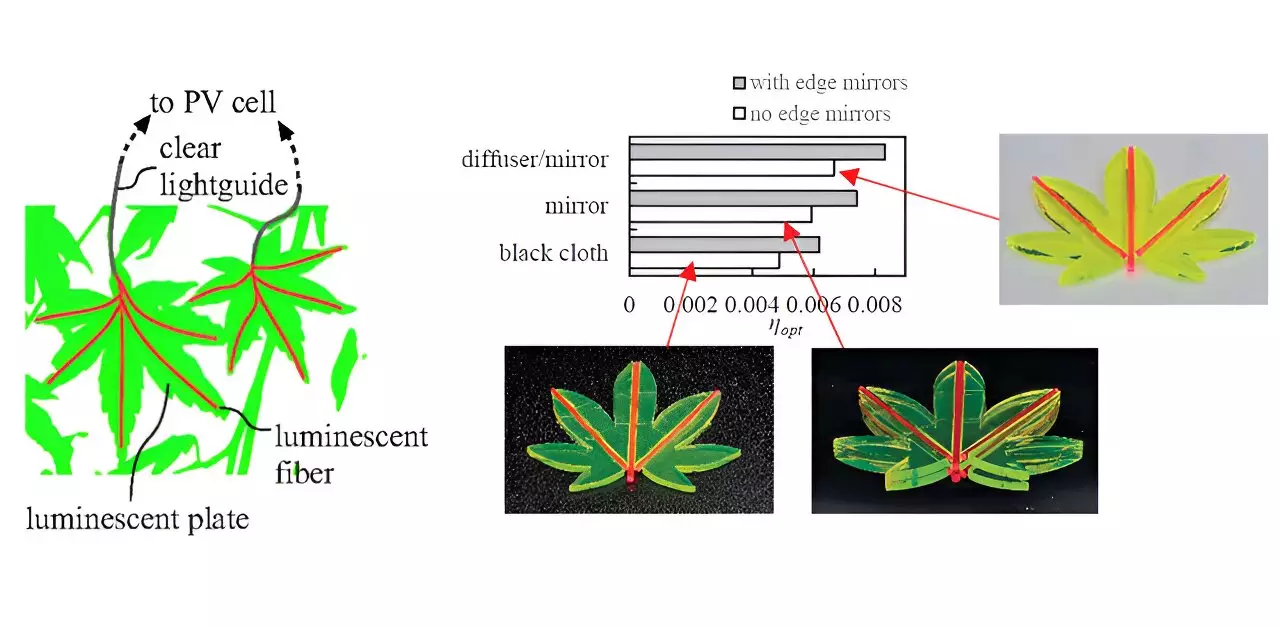The world of renewable energy is consistently evolving, with solar power taking a lead role in the quest for sustainable solutions. Among the innovative technologies emerging within this field is the luminescent solar concentrator (LSC), which has gained traction since its inception in the 1970s. Unlike traditional solar concentrators that rely on mirrors and lenses, LSCs leverage luminescent materials to collect sunlight and focus it onto photovoltaic (PV) cells. This feature allows LSCs to harness not only direct sunlight but also diffuse light, offering a unique advantage for various applications, especially in building-integrated photovoltaics (BIPV).
However, despite their potential benefits, these technologies face challenges, particularly in scaling them up for broader applications. Issues such as self-absorption of photoluminescent (PL) photons within the LSC’s waveguide hinder efficiency, leading researchers to seek innovative solutions for these limitations.
The Leaf LSC Concept: A Paradigm Shift
A team of researchers from Ritsumeikan University in Japan has proposed a groundbreaking design known as the “leaf LSC.” This model is inspired by nature and offers a fresh approach to addressing the scalability and efficiency issues prevalent in traditional LSC designs. Instead of employing large, flat panels, the leaf LSC configuration comprises smaller, interlinked luminescent components arranged similarly to leaves on a tree.
The design allows luminescent plates to encircle a central luminescent fiber, optimizing the capture of incident light. When photons strike the plates, they are converted into PL photons that travel through the fiber and ultimately get collected by a PV cell at the end. This modular arrangement not only enhances the collection and transfer of light but also mitigates the detrimental effects of photon loss due to absorption and scattering.
Enhancing Efficiency through Modularity
One of the standout features of the leaf LSC design is its modularity. By prioritizing smaller component sizes—reducing the side length of square leaf concentrators from 50 mm to 10 mm—researchers observed a significant boost in photon collection efficiency. This strategy is rooted in the principle that smaller modules can minimize the distance photons travel, ultimately reducing losses.
Moreover, the modular system allows for easy maintenance and replacement of damaged components. As advancements in luminescent materials occur, such as the development of more efficient or environmentally friendly compounds, this modular approach facilitates the integration of these innovations, thereby continuously elevating system performance.
In a bid to further enhance the functionalities of the leaf LSC model, researchers have integrated strategies from conventional planar LSC technologies. Techniques such as using edge mirrors and developing tandem structures have proven advantageous. The experiments conducted revealed that the optical efficiency of these leaf-inspired structures could be quantitatively analyzed based on the light spectrum and intensity, leveraging a single-spot excitation technique.
As conveyed by Sean Shaheen, editor-in-chief of the Journal of Photonics for Energy and a professor at the University of Colorado Boulder, the research signifies a creative leap forward in the realm of luminescent solar concentrators. He emphasizes the significance of merging bio-inspired designs with advances in optical engineering, heralding a future where solar energy systems become more efficient and practical for diverse applications.
The advent of the leaf LSC model may serve as a catalyst for a paradigm shift in solar energy capture strategies. Its flexible and scalable design holds promise for various applications, from extensive solar farms to stylish BIPV installations that blend seamlessly with architectural aesthetics. As research continues to examine and optimize these systems, we may witness a transformation in how solar energy is harvested and utilized.
The integration of innovative models like the leaf LSC could redefine efficiency metrics for solar concentrators. This evolution not only promises enhanced performance but also contributes to the broader goal of achieving sustainable energy solutions. The advancements demonstrated within this research can potentially illuminate the path toward a more efficient and adaptable future for solar energy technologies, making a substantial impact on our collective energy landscape.

